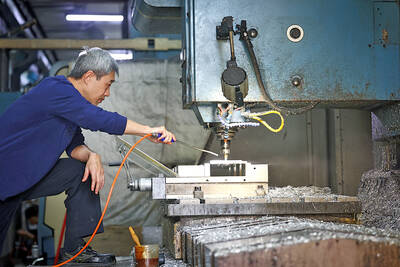Elpida Memory Inc, Japan's No. 1 computer memory chipmaker, may seek an alliance with Nanya Technology Corp (南亞科技) or ProMOS Technologies Inc (茂德科技) to challenge Samsung Electronics Co for global market share.
"If a Taiwanese chipmaker such as ProMOS or Nanya were to join us," combined production may exceed Samsung's, Elpida CEO Yukio Sakamoto said in an interview in Tokyo on Tuesday.
"It would make us that much stronger," he said, adding that no negotiations had begun.
A second alliance with a Taiwanese company would enable Elpida to expand production without having to invest billions of dollars to build its own production lines as chip prices trade at record lows. The Tokyo-based chipmaker forged a partnership with Hsinchu-based Powerchip Semiconductor Corp (
"Allying with a Taiwanese maker would be a natural move for the company," said Takeo Miyamoto, an analyst at CLSA Asia-Pacific Markets, who has a "buy" rating on Elpida.
ProMOS is a better candidate because it uses the same manufacturing technology as Elpida, he said.
Nanya spokesman Pai Pei-lin (
ProMOS spokesman Ben Tseng (
James Chung, a Samsung spokesman in Seoul, declined to comment.
Eric Tang (
"It is good timing" for further consolidation in the computer memory chip industry, Tang said. "We have a mutual consent."
Shares of Elpida rose 3.6 percent to ?3,460 on the Tokyo Stock Exchange today, their first gain in 10 days. ProMOS rose 2.3 percent and Nanya declined 3.8 percent in Taipei trading.
Rexchip Electronics Co (
A glut of computer chips known as dynamic random access memory (DRAM) drove down prices, leading to lower earnings at South Korea's Samsung Electronics and Hynix Semiconductor Inc in the latest quarter, while Elpida posted its smallest profit in six quarters. Powerchip, Nanya, Qimonda AG and Micron Technology Inc posted losses in the latest period.
"With prices falling this low, the industry is ripe for reorganization," Miyamoto said.
The Dramexchange Index, which tracks the most widely used types of computer memory, has tumbled 41 percent this year.
Some DRAM makers will choose to quit the business when chip prices fall below US$1, leaving only the top three, Sakamoto said. Prices of 512-megabit chips are already trading at less than US$1 each, according to Taipei-based DRAMeXchange.com (

SEEKING CLARITY: Washington should not adopt measures that create uncertainties for ‘existing semiconductor investments,’ TSMC said referring to its US$165 billion in the US Taiwan Semiconductor Manufacturing Co (TSMC, 台積電) told the US that any future tariffs on Taiwanese semiconductors could reduce demand for chips and derail its pledge to increase its investment in Arizona. “New import restrictions could jeopardize current US leadership in the competitive technology industry and create uncertainties for many committed semiconductor capital projects in the US, including TSMC Arizona’s significant investment plan in Phoenix,” the chipmaker wrote in a letter to the US Department of Commerce. TSMC issued the warning in response to a solicitation for comments by the department on a possible tariff on semiconductor imports by US President Donald Trump’s

The government has launched a three-pronged strategy to attract local and international talent, aiming to position Taiwan as a new global hub following Nvidia Corp’s announcement that it has chosen Taipei as the site of its Taiwan headquarters. Nvidia cofounder and CEO Jensen Huang (黃仁勳) on Monday last week announced during his keynote speech at the Computex trade show in Taipei that the Nvidia Constellation, the company’s planned Taiwan headquarters, would be located in the Beitou-Shilin Technology Park (北投士林科技園區) in Taipei. Huang’s decision to establish a base in Taiwan is “primarily due to Taiwan’s talent pool and its strength in the semiconductor

Industrial production expanded 22.31 percent annually last month to 107.51, as increases in demand for high-performance computing (HPC) and artificial intelligence (AI) applications drove demand for locally-made chips and components. The manufacturing production index climbed 23.68 percent year-on-year to 108.37, marking the 14th consecutive month of increase, the Ministry of Economic Affairs said. In the first four months of this year, industrial and manufacturing production indices expanded 14.31 percent and 15.22 percent year-on-year, ministry data showed. The growth momentum is to extend into this month, with the manufacturing production index expected to rise between 11 percent and 15.1 percent annually, Department of Statistics

An earnings report from semiconductor giant and artificial intelligence (AI) bellwether Nvidia Corp takes center stage for Wall Street this week, as stocks hit a speed bump of worries over US federal deficits driving up Treasury yields. US equities pulled back last week after a torrid rally, as investors turned their attention to tax and spending legislation poised to swell the US government’s US$36 trillion in debt. Long-dated US Treasury yields rose amid the fiscal worries, with the 30-year yield topping 5 percent and hitting its highest level since late 2023. Stocks were dealt another blow on Friday when US President Donald